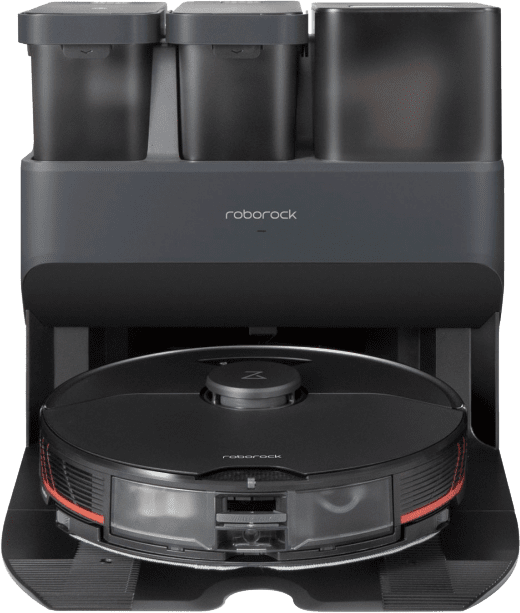Hot on the heels of the S7's successful launch, Roborock has upped their game with a fresh line of robot vacuum cleaners. The new range, equipped with the MaxV camera system for smart obstacle avoidance, is certainly impressive. But it's the Roborock S7 MaxV Ultra that's set to leave its competitors in the dust.

The backstory
Before we dive in, let's quickly revisit the Roborock S7. Many have hailed this bad boy as the first robot vacuum cleaner that's not just good but excellent at mopping. Unlike its peers, which often do little more than drag a damp cloth across your floor, the Roborock S7 employs sonic vibration technology to scrub your floors 3,000 times per minute. If you're thinking that sounds like a gimmick, think again. Sonic vibration is a real deal tech, as anyone who's ever used an electric toothbrush would know.
However, the S7 was merely a partial upgrade to its predecessor, the Roborock S6 MaxV, which utilized a pair of forward-facing cameras to dodge objects in its path. You might be wondering why a vacuum cleaner would need vision. Well, as someone whose kids are constantly leaving their toy cars around, I can vouch for the practicality of a vacuum that can avoid small obstacles. Pet owners with the occasional "oops" to clean up will likely share my sentiment.

Now, with the Roborock S7 MaxV series, potential buyers can enjoy the best features of the original S7, like its sonic mopping and LiDAR navigation, and so much more.
The new and improved Roborock S7 MaxV
The three models in the S7 MaxV series share one common denominator: the robot vacuum cleaner itself. The Roborock S7 MaxV is a substantial step up from the S7 and remains consistently excellent across all models. It addresses the primary criticism of its predecessor, the suction power, by taking it up a notch. The S7 MaxV boasts the same all-rubber brush—praised by Roborock for its resistance to hair tangles—but ups the suction game from 2500 Pa to a whopping 5100 Pa. This is an upgrade that won't go unnoticed.

In addition to the suction and vision enhancements, the Roborock S7 MaxV has a smaller dustbin and water tank, likely due to the more robust motor, extra sensors, and improved SoC for image processing that take up some extra room. However, the dustbin size won't matter if you're eyeing the S7 MaxV Plus or Ultra (more on these models shortly).
Otherwise, the Roborock S7 and S7 MaxV are pretty much identical. They both have the ability to detect carpets and retract the mop, feature adaptive route algorithms, and zone-cleaning capabilities. The LiDAR sensor pod is present on both models, and maps can be saved on either device. They also share the same 180-minute runtime in quiet mode, and their sizes are identical.
| Roborock S7 | Roborock S7 MaxV | |
|---|---|---|
| Suction | 2500 Pa | 5100 Pa |
| Colours | Black or white | Black |
| Dustbin volume | 470ml | 400ml |
| Water tank capacity | 300ml | 200ml |
| ReactiveAI Obstacle Avoidance | No | Yes |
Roborock S7 MaxV's ReactiveAI gets a serious upgrade
Roborock is making some bold statements about their updated vision system, ReactiveAI 2.0. Apparently, it's 22% more accurate and 70% faster than the system on their previous model, the S6 MaxV. Given that the S6 MaxV hit the market in June 2020 and tech evolution is a never-ending race, this claim doesn't sound too far-fetched. However, Roborock adds a caveat that these figures might vary depending on the environment.
The latest tech wizardry in the Roborock S7 MaxV involves sensors that perform structured light 3D scanning, a technology similar to what iPhones use for facial detection. These sensors project dots invisible to the naked eye, enabling the robot to navigate even in low light conditions.
Roborock also acknowledges the elephant in the room – privacy concerns. The idea of a mobile camera roving around your smart home might sound like a scene from a dystopian sci-fi film. But, fear not! The ReactiveAI 2.0 on the Roborock S7 MaxV doesn't save any images unless you give it the green light. To back up their privacy claims, Roborock has earned a certification from TÜV Theinland, asserting the S7 MaxV as a safe smart home product.
The Roborock S7 MaxV Ultra: Not just a vacuum cleaner, but a self-cleaning marvel
Now that we've covered the Roborock S7 MaxV and its enhanced ReactiveAI 2.0, let's dive into what sets the three models apart: the dock. The S7 MaxV Plus seems to sport a similar, if not identical, auto-empty dock that can be bought for the basic S7. But the S7 MaxV Ultra is in a league of its own. Its dock not only empties the dustbin, but also cleans the mop and refills the water tank.

What's more, the upgraded dock juices up the vacuum cleaner 30% faster than its predecessors, making it an absolute godsend for those with sprawling floors.
Yes, the dock is a tad bigger than any I've seen so far, but it's got a lot on its plate. It needs to accommodate three tanks – one for fresh water, one for used water, and a dustbin, as well as the mechanics for cleaning the mop. Considering everything the Roborock S7 MaxV Ultra brings to the table, it seems like the most autonomous robot vacuum cleaner in the market. However, all this tech wizardry comes with a hefty price tag. The Roborock S7 MaxV Ultra will hit the shelves for a whopping $1,399 in the second quarter of 2022.
